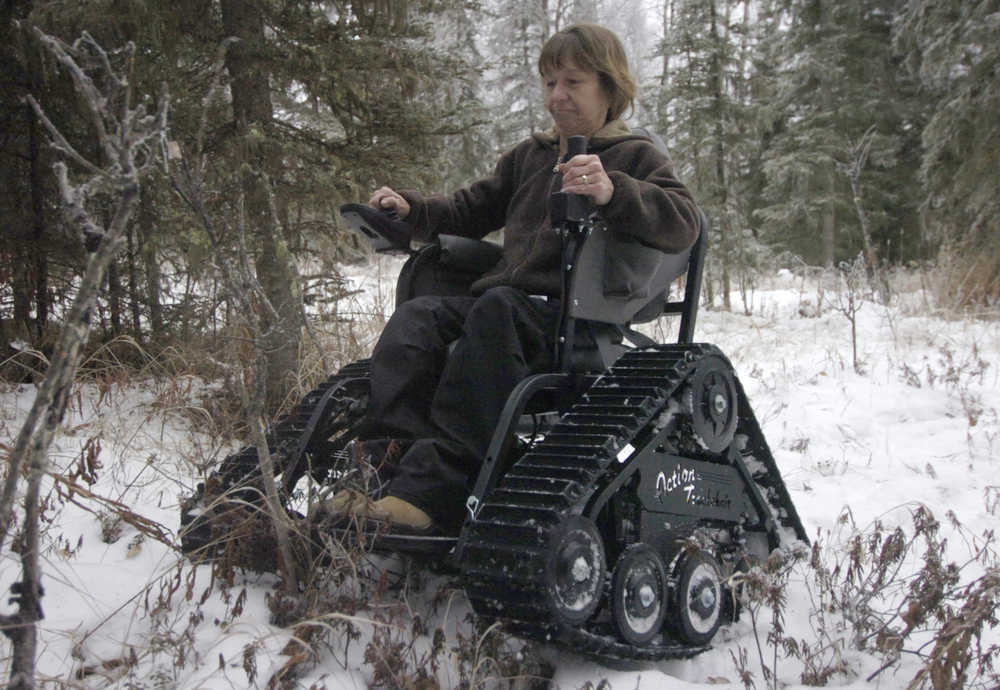On her wooded property outside of Soldotna, Jill Erickson had a hill which, until recently, she had never been to the top of.
Erickson, a physical therapist, has been paralyzed from the waist down for 35 years and uses a wheelchair for transportation, which severely limited her outdoor mobility. Last week, Erickson used her new all-terrain wheelchair to travel up the hill for the first time.
“You can’t imagine how much it means to me to be outdoors by myself,” Erickson said.
Her new chair is an Action trackchair, a 2008 invention of motor-sport manufacturer Tim Swenson of Minnesota. It was assembled by Swenson’s company Action Manufacturing, which to date has only one plant, located in Marshall, Minnesota. Instead of wheels, the 350-pound chair has heavy treads similar to a snowmachine’s. These are powered by a pair of 12-volt rechargeable batteries beneath the seat, which can propel the chair to a top speed of 4 miles per hour, according to its user manual.
Erickson’s trackchair, which she received Dec. 6, is the first to be shipped to the Kenai Peninsula, according to Mary and Richard Dreifuerst, co-owners of Alaska Trackchair, currently the only trackchair dealer in Alaska. They run the dealership from their home in Cooper Landing, and have two model trackchairs on display at Sportsman’s Warehouse in Soldotna, priced for $11,183.
“It gives people with limited mobility the ability to get back out and go down to the river to fish, or to get on a hiking trail, or walk their dog, get back out with their families and be independent without someone pushing your wheelchair. It’s able to get to places where traditional wheelchairs just can’t go,” said Mary Dreifuerst.
The Dreifuersts founded their business a year ago. They said that a friend — a trackchair user and owner of a hunting business in their native state of Wisconsin — introduced them to the product.
“It intrigued me, that they made a vehicle like this,” said Richard Dreifuerst. “So I met up with the sales manager (of Action Trackchair).”
The manager told Dreifuerst that Action Trackchair had received many inquiries about the product from Alaska, where the couple had lived for 40 years, but that the company didn’t want to ship chairs to areas that lacked training and maintenance support for users.
“They were really interested in having somebody in Alaska as a dealer,” said Richard Dreifuerst. He and his wife stepped into that role.
Richard Dreifuerst has tested the chair on Alaska beaches, hills, and trails, and said “it can go through a lot.”
“We realized it would be a great thing to bring to Alaska,” said Mary Dreifuerst. “A lot of people up here are outdoor enthusiasts, and now they can get back out there. We’re really excited to bring it here.”
Although most insurance policies don’t cover the trackchair, the Dreifuersts said that Action Trackchair has recently been given an official medical code for its product, allowing it to be prescribed by doctors. This may encourage its adoption by insurance agencies.
One population that the Dreifuersts believe could benefit from the trackchair are disabled veterans. Andrew Liebig of Wasilla is a wounded veteran, a trackchair user, and an Alaska coordinator for the Independence Fund, a nation-wide aid organization for wounded veterans that has distributed more than 750 trackchairs to veterans nationwide. With aid from the Independence Fund, Liebig received Alaska Trackchair’s first sale this June.
The Veteran’s Administration does not currently give veterans funding to purchase trackchairs.
“It’s not a supported piece of equipment,” said Liebig, of the VA’s policy on trackchairs. “That’s where the Independence Fund comes in.”
Liebig doesn’t know how many wounded veterans in Alaska may be eligible to receive trackchairs through the Independence Fund, but he said, “I can only imagine that there would be a lot of folks out there who would qualify based on their disabilities.”
The Dreifuersts found Jill Erickson through a group she belongs to. Ten years ago, Erickson was a leader of the Kenai chapter of Challenge Alaska, a group that she said “provides recreation for disabled people” by organizing outings and teaching skills such as skiing and kayaking to those with limited mobility. Although the Kenai chapter no longer exists, Erickson is still an active member of Challenge Alaska, and it is because of this, she said, that the Dreifuersts sent her a brochure for the trackchair last year.
“They knew me as a physical therapist, then when I talked to them … they asked if I could help promote it with Challenge Alaska,” she said. “So I think it was for (several) reasons: because of people I might be able to help, for myself, and to help their business market this chair and get the word out.”
Erickson said that Dreifuersts approached her about a year ago, and since then she had been considering purchasing a chair for herself.
“I thought about it a little bit, and then I decided, ‘You know, I think I want one of those,’” Erickson said.
Although she doesn’t expect the trackchair to be relevant to her work as a therapist, Erickson said that she won’t rule out the possibility of promoting it to her patients.
“I don’t get a lot of people in my situation as patients,” she said. “But any time I do get a patient … with a disability where walking is an issue, I’d definitely recommend getting something like this,”
Erickson plans to accessorize her wheelchair with a fishing rod holder, a gun rack, and a shooting mount for her hunting rifle. With only a week of practice, she is still learning to use the chair, but said that she plans eventually to take it on a trip to the Lower Russian River with her husband, a fishing guide.
“I’m pretty sure I’ll be able to do it,” said Erickson. “I’ve done it in my manual chair, with a little bit of help, but with this thing I won’t need anyone to push me.”

